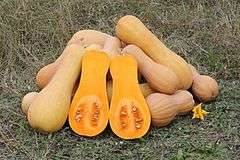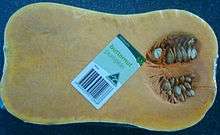Butternut squash
| Butternut squash | |
|---|---|
 Ripe butternut squash | |
| Species | Cucurbita moschata |
| Hybrid parentage | 'Gooseneck squash' × 'Hubbard squash' |
| Breeder | Charles Leggett |
| Origin | 1940s in Stow, Massachusetts, United States |


Butternut squash (Cucurbita moschata), sometimes known in Australia and New Zealand as butternut pumpkin or gramma,[1] is a type of winter squash that grows on a vine. It has a sweet, nutty taste similar to that of a pumpkin. It has tan-yellow skin and orange fleshy pulp with a compartment of seeds in the bottom. When ripe, it turns increasingly deep orange, and becomes sweeter and richer. It is a good source of fiber, vitamin C, magnesium, and potassium; and it is a source of vitamin A.
Although technically a fruit, butternut squash is used as a vegetable that can be roasted, sautéed, toasted, puréed for soups such as squash soup, or mashed to be used in casseroles, breads, muffins, and pies.
History
The most popular variety, the Waltham Butternut, originated in Waltham, Massachusetts, where it was developed at the Waltham Experiment Station by Robert E. Young.[2][3][4] Dorothy Leggett claims that the Waltham Butternut squash was developed during the 1940s by her late husband, Charles Leggett, in Stow, Massachusetts, and then subsequently introduced by him to the researchers at the Waltham Field Station.[5] She also claimed that name came from "smooth as butter, sweet as nut".[6]
Culinary uses
One of the most common ways to prepare butternut squash is roasting. To do this, the squash is cut in half lengthwise (see pictures), lightly brushed with cooking oil or put in a thin layer of water and placed cut side down on a baking sheet. It is then baked for 45 minutes or until soft. Once roasted, it can be eaten in a variety of ways.[7]
| Nutritional value per 100 g (3.5 oz) | |
|---|---|
| Energy | 188 kJ (45 kcal) |
|
11.69 g | |
| Dietary fiber | 2 g |
|
0.1 g | |
|
1 g | |
| Vitamins | Quantity %DV† |
| Vitamin A equiv. |
67% 532 μg39% 4226 μg |
| Thiamine (B1) |
9% 0.1 mg |
| Riboflavin (B2) |
2% 0.02 mg |
| Niacin (B3) |
8% 1.2 mg |
| Pantothenic acid (B5) |
8% 0.4 mg |
| Vitamin B6 |
12% 0.154 mg |
| Folate (B9) |
7% 27 μg |
| Vitamin C |
25% 21 mg |
| Vitamin E |
10% 1.44 mg |
| Minerals | Quantity %DV† |
| Calcium |
5% 48 mg |
| Iron |
5% 0.7 mg |
| Magnesium |
10% 34 mg |
| Manganese |
10% 0.202 mg |
| Phosphorus |
5% 33 mg |
| Potassium |
7% 352 mg |
| Zinc |
2% 0.15 mg |
|
| |
| |
|
†Percentages are roughly approximated using US recommendations for adults. Source: USDA Nutrient Database | |
The fruit is prepared by removing the skin, stalk, and seeds, which are not usually eaten or cooked.[8] However, the seeds are edible, either raw or roasted, and the skin is also edible and softens when roasted.
Australia
In Australia, it is regarded as a pumpkin, and is used interchangeably with other types of pumpkin.
South Africa
In South Africa, butternut squash is commonly used and often prepared as a soup or grilled whole. Grilled butternut is typically seasoned with spices such as nutmeg and cinnamon or stuffed (e.g. spinach and feta) before being wrapped in foil and grilled. Grilled butternut is often served as a side dish to braais (barbecues) and the soup as a starter dish.
New Zealand
Butternuts were introduced commercially in New Zealand in the 1950s by brothers Arthur and David Harrison who were nurserymen and market gardeners in Otaki.
See also
References
- ↑ "Commercial production of pumpkins and grammas". Department of Agriculture and Fisheries. Retrieved 29 June 2016.
- ↑ Massachusetts Department of Agriculture Farm & Market Report, Vol. 78, No. 10, October 2001
- ↑ "Obituaries: Robert E. Young". The Campus Chronicle. 21 September 2001. Retrieved 16 November 2014.
- ↑ Arena, Al (2009-10-28). "Interview/Discussion Report for Waltham Farming History Project" (Interview). Interviewed by Nicole Chan. Waltham.
|access-date=requires|url=(help) - ↑ "A Familiar Squash with Surprising Origins". Apple Country Living. Retrieved 15 September 2013.
- ↑ "History of Cucurbita Moschata (Butternut Squash)". tropical-fresh.com. Retrieved 13 January 2017.
- ↑ "Butternut Squash". Traditional-Foods.com. 2011. Archived from the original on 7 January 2012. Retrieved 7 January 2012.
- ↑ "Butternut Squash". Veg Box Recipes. 2008. Retrieved 15 September 2013.
External links
| Wikispecies has information related to Cucurbita moschata |
| Wikimedia Commons has media related to Cucurbita moschata bell group. |
